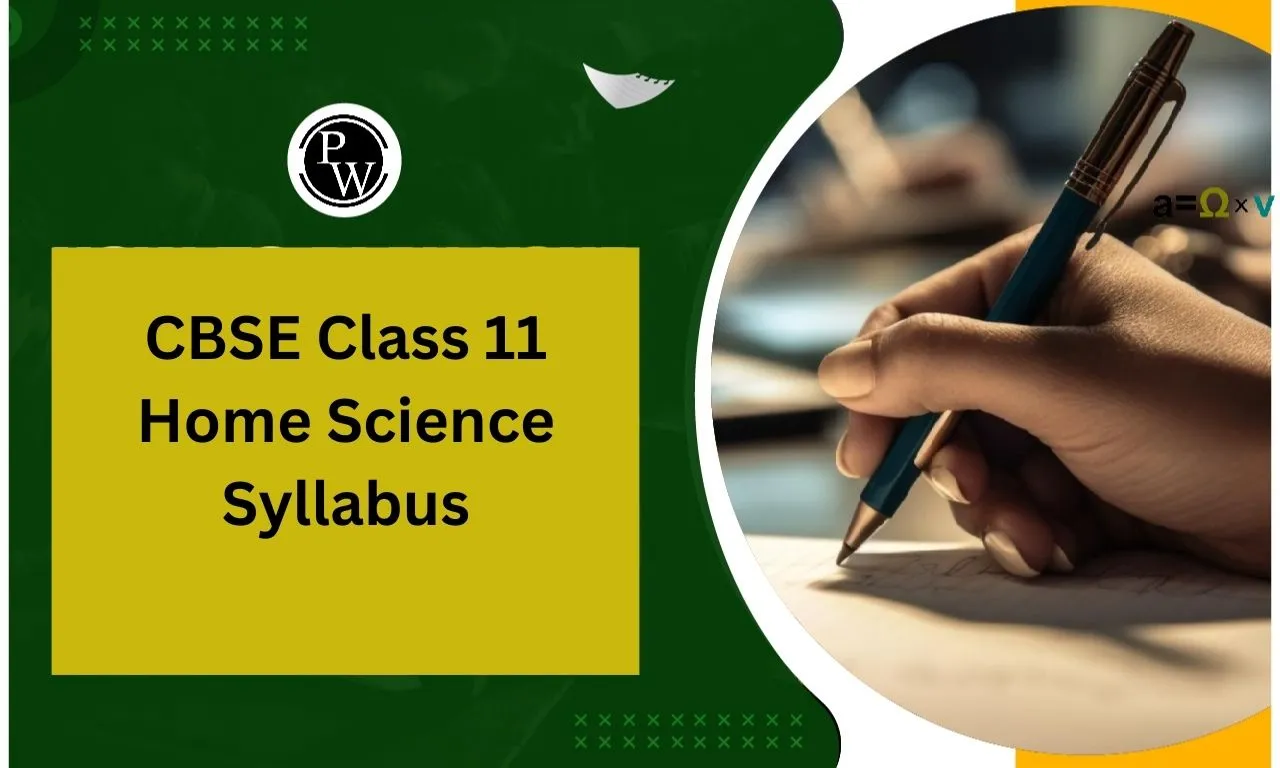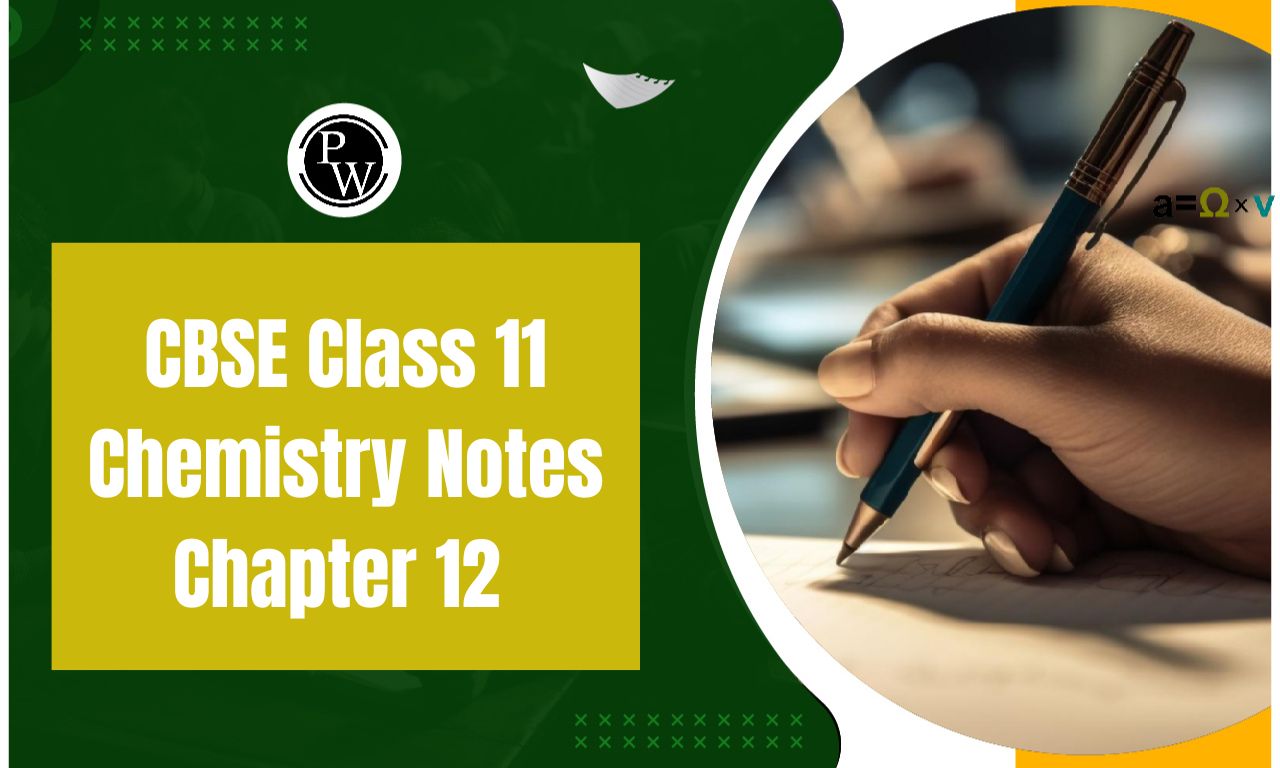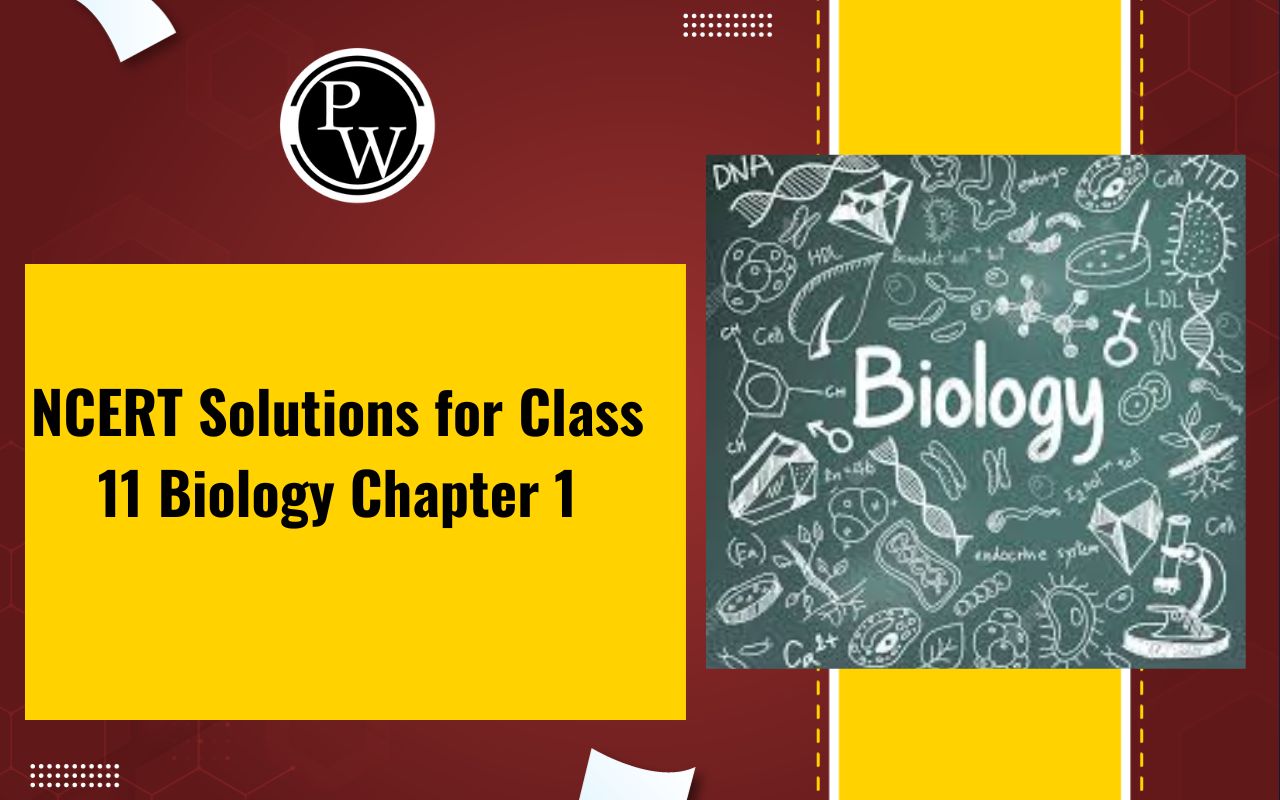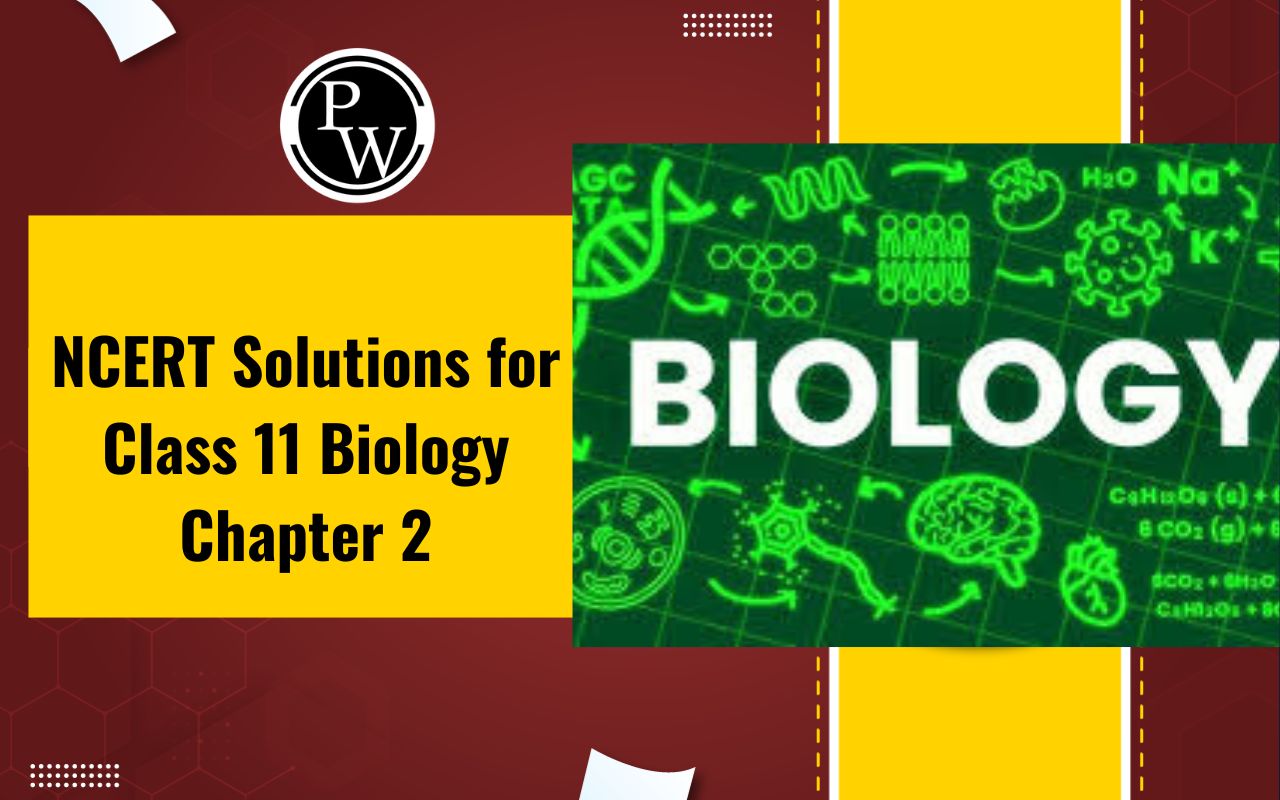
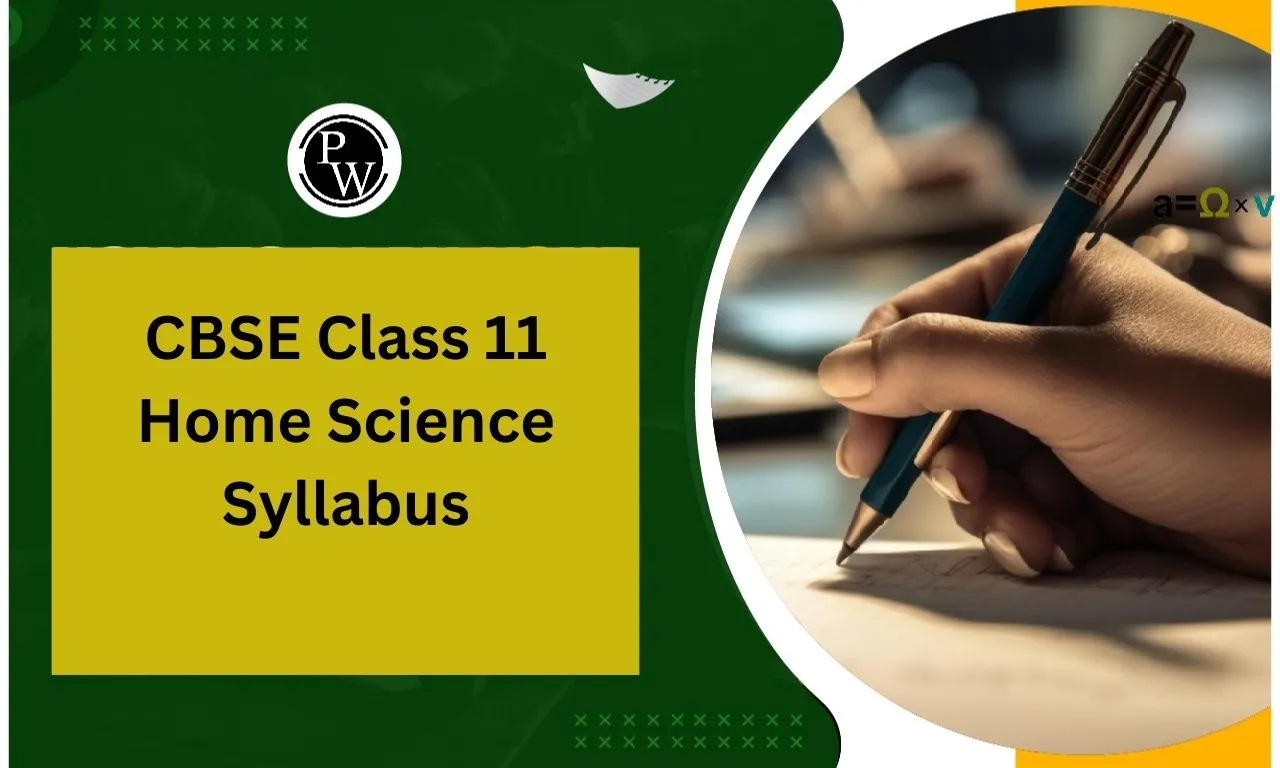
CBSE Class 11 Home Science Syllabus: CBSE has released the official Class 11 Home Science Syllabus for the academic year 2025-26.
This updated syllabus is created to provide students with a thorough understanding of various aspects of home science, including food and nutrition, textiles, human development, family resource management, and extension education.
It emphasizes both theoretical knowledge and practical skills, preparing students to apply what they learn in real-life scenarios.
The syllabus also integrates life skills such as communication, resource management, and family welfare, aiming to equip students with the knowledge necessary for personal growth and future career opportunities in fields related to home science.
CBSE Class 11 History Syllabus 2025
CBSE Class 11 Home Science Syllabus 2025-26 Overview
The CBSE Class 11 Home Science syllabus for the 2025-26 academic year offers a comprehensive exploration of various facets of individual and societal development.
Structured into five units, the course begins with an introduction to Home Science, establishing its relevance and scope. It then delves into Human Development across the lifespan, emphasizing adolescence, childhood, and adulthood, highlighting physical, emotional, and social growth.
Subsequent units focus on Food, Nutrition, Health, and Fitness, alongside Family and Community Resources, providing insights into nutritional well-being and resource management.
The curriculum also covers Fabric and Apparel, examining textile properties and their applications. Practical assessments complement theoretical knowledge, ensuring a holistic educational experience.
CBSE Class 11 Home Science Syllabus 2025-26
Here is an overview of the CBSE Class 11 Syllabus for Home Science for the academic year. This syllabus provide a comprehensive breakdown of the units, key topics, and marks distribution.
|
Title |
Details |
|
Released By |
Central Board of Secondary Education (CBSE) |
|
Class |
11 |
|
Subject |
Home Science |
|
Academic Year |
2025-26 |
|
Purpose |
To provide a structured curriculum that helps students understand the fundamentals of Home Science. |
|
Course Structure |
Covers major units: Understanding of food, nutrition, health, and hygiene; Textile and clothing; Human Development; and Family and community resources. |
|
Marks Distribution |
Theory: 70 marks (for written exams) + Practical: 30 marks |
|
Practical Work |
Included to develop hands-on skills in food preparation, nutrition analysis, and family resource management. |
CBSE Class 11 Geography Syllabus 2025
Marks Distribution of CBSE Class 11 Home Science Syllabus
The CBSE Class 11 Home Science syllabus for the academic year is created to assess students knowledge through both theoretical and practical evaluations. Below is the detailed marks distribution for the subject:
|
No. |
Units |
Marks |
|
1 |
Introduction to Home Science |
2 |
|
2 |
Understanding Oneself: Adolescence |
20 |
|
3 |
Understanding Family, Community, and Society |
15 |
|
4 |
Childhood |
15 |
|
5 |
Adulthood |
18 |
|
Total Theory Marks |
70 |
|
|
Practical Marks |
30 |
|
|
Grand Total |
100 |
CBSE Class 11 Home Science Syllabus 2025-26 Unit Wise
The CBSE Class 11 Home Science syllabus for the 2025-26 academic year is divided into five units, each focusing on different aspects of Home Science, such as understanding oneself, nutrition, health, family, community, and adult life. Here's an outline of the syllabus:
CBSE Class 11 Home Science Syllabus 2025-26 For UNIT I
This unit provides an introduction to the field of Home Science. It lays the foundation for understanding the different areas of Home Science, its significance, and its relevance for both boys and girls.
-
What is Home Science : An interdisciplinary field focusing on the well-being of individuals, families, and communities through subjects like nutrition, health, and family management.
-
Areas of Home Science : Includes Nutrition and Health, Human Development, Family Resource Management, Textiles and Clothing, and Extension Education.
-
Home Science is Important for Both Boys and Girls : It equips both boys and girls with practical life skills like cooking, budgeting, and time management.
-
Career Options in Home Science : Careers include Nutritionist, Fashion Designer, Child Development Specialist, Educator, Entrepreneur, and Therapist.
CBSE Class 11 Home Science Syllabus For UNIT II : UNDERSTANDING ONESELF: ADOLESCENCE
Unit II focuses on the adolescent stage, helping students understand their personal identity, health and nutrition, communication skills, and resource management. It also discusses the development of self-concept and the influences of biological, socio-cultural, emotional, and cognitive changes.
CHAPTER: UNDERSTANDING THE SELF
-
What is Self?
-
Personal dimension
-
Social dimension
-
Self-concept
-
Self-esteem
-
-
What is Identity?
-
Personal identity
-
Social identity
-
-
Self during Infancy: Characteristics
-
Self during Early Childhood: Characteristics
-
Self during Middle Childhood: Characteristics
-
Self during Adolescence: Characteristics
-
Identity development
-
Identity crisis
-
Real vs Ideal self
-
-
Influences on Identity
-
Developing a sense of self and identity
-
Influences on formation of identity
-
Biological and physical changes
-
Socio-cultural context
-
Emotional changes
-
Cognitive changes
-
CHAPTER: FOOD, NUTRITION, HEALTH AND FITNESS
-
Introduction
-
Definition of:
-
Food
-
Nutrition
-
Nutrients
-
-
Balanced Diet
-
Definition
-
RDA
-
-
Health and Fitness
-
Using Basic Food Groups for Planning Balanced Diets
-
Food guide pyramid
-
Vegetarian Food Guide
-
Dietary Patterns in Adolescence
-
Irregular meals and skipping meals
-
Snacking
-
Fast foods
-
Dieting
-
-
Modifying Diet-Related Behaviour
-
Diet journal
-
Exercise
-
Substance use and abuse
-
Healthy eating habits
-
Snacks
-
Drinking water
-
-
Factors Influencing Eating Behaviour
-
Eating Disorders at Adolescence
-
Key terms and their meaning
CHAPTER: MANAGEMENT OF RESOURCES
-
Introduction
-
Classification of Resources
-
Human / Non-Human Resources
-
Individual / Shared Resources
-
Natural / Community Resources
-
Human and Non-Human Resources
-
Knowledge
-
Motivation/Interest
-
Skills/Strength/Aptitude
-
Time
-
Energy
-
Money
-
Material resources
-
-
Human Resources
-
Non-Human Resources
-
Individual and Shared Resources
-
Individual Resources
-
Shared Resources
-
Natural and Community Resources
-
Natural Resources
-
Community Resources
-
Characteristics of Resources
-
Utility
-
Accessibility
-
Interchangeability
-
Manageable
-
Managing Resources
-
Management process
-
Planning
-
Steps in Planning
-
Organizing
-
Implementing
-
Controlling
-
Evaluation
CHAPTER: FABRIC AROUND US
-
Definition of:
-
Yarns
-
Fibres
-
Textile products
-
Finishing
-
Introduction to Fibre Properties
-
Classification of Textile Fibres
-
Filament/Staple fibres
-
Natural/Manufactured (Manmade) fibres
-
Types of Natural Fibres
-
Cellulosic fibres
-
Protein fibres
-
Mineral fibres
-
Natural rubber
-
Types of Manufactured Fibres
-
Regenerated cellulosic fibres
-
Modified cellulosic fibres
-
Protein fibres
-
Non-cellulosic fibres
-
Mineral fibres
-
Some Important Fibres and Their Properties
-
Cotton
-
Linen
-
Wool
-
Silk
-
Rayon
-
Nylon
-
Polyester
-
Acrylic
-
Elastomeric fibres
-
Yarns
-
Yarn Processing
-
Cleaning
-
Making into a sliver
-
Attenuating, drawing out, and twisting
-
Yarn Terminology
-
Yarn number
-
Yarn twist
-
Yarn and thread
-
Fabric Production
-
Weaving
-
Knitting
-
Braiding
-
Nets
-
Laces
-
Textile Finishing
-
Finishing with colour
-
Printing
CHAPTER : MEDIA COMMUNICATION TECHNOLOGY
-
Communication and Communication Technology
-
What is Communication?
-
Classification of communication
-
How does communication take place?
-
What is Media?
-
Media classification and functions
-
What is Communication Technology?
-
Classification of communication technologies
-
Modern communication technologies
CBSE Class 11 Home Science Syllabus For UNIT III: Understanding, Family, Community And Society
This unit focuses on relationships, concerns, and needs in family, community, and societal contexts. It discusses health, work, education, resources, and the role of textiles in diverse social contexts.
CHAPTER: CONCERNS AND NEEDS IN DIVERSE CONTEXTS
A. NUTRITION, HEALTH AND HYGIENE
-
Health and its Dimensions
-
Social health
-
Mental health
-
Physical health
-
Health Care Indicators of Health
-
Nutrition and Health
-
Importance of Nutrients
-
Factors Affecting Nutritional Well-being
-
Food and nutrient security
-
Care for the vulnerable
-
Good health for all
-
Safe environment
-
Nutritional Problems and Their Consequences
-
Malnutrition
-
Under nutrition
-
Over nutrition
-
Hygiene and Sanitation
-
Personal hygiene
-
Environmental hygiene
-
Food hygiene
-
Water safety: qualities of potable water, methods of water purification (boiling, chlorine, storage, and electric filter, RO)
B. RESOURCES AVAILABILITY AND MANAGEMENT
-
Time Management
-
Definition of time plan
-
How good is your time management (Activity)?
-
Steps in making time plan
-
Tips for effective time management
-
Tools in time management: Peak load period, Work curve, Rest/break periods, Work simplification
-
Space Management
-
Space and the home
-
Principles of space planning
CBSE Class 11 Home Science Syllabus For UNIT IV: CHILDHOOD
The theme of this unit revolves around childhood and the various stages of growth and development from infancy through preschool years. It emphasizes health, nutrition, education, and clothing needs for children, as well as the inclusion of children with disabilities.
CHAPTER: SURVIVAL GROWTH AND DEVELOPMENT
-
The Meaning of Survival
-
Growth and Development
-
Areas of Development
-
Physical development
-
Motor development
-
Cognitive development
-
Sensory development
-
Language development
-
Social development
-
Emotional development
-
-
Good Nutrition
-
Stages in Development
-
Neonate
-
Reflexes
-
Sensory capabilities
-
-
-
Development Across Stages from Infancy to Adolescence
-
Physical and motor development
-
Language development
-
Socio-emotional development
-
Cognitive development
-
Mental processes involved in thinking
-
Stages of cognitive development
-
Sensory motor stage
-
Pre-operational stage
-
Concrete operational stage
-
Formal operational stage
-
-
CHAPTER: NUTRITION, HEALTH AND WELL-BEING
-
Introduction
-
Nutrition, Health, and Well-being during Infancy (Birth – 12 months)
-
Dietary requirements of infants
-
Breast feeding
-
Benefits of breast feeding
-
Feeding the low birth weight infants
-
Complementary foods
-
Guidelines for complementary feeding
-
Immunization
-
Common health and nutrition problems in infants and young children
-
-
Nutrition, Health, and Well-being of Preschool Children (1-6 years)
-
Nutritional needs of preschool children
-
Guidelines for healthy eating for preschoolers
-
Planning balanced meals for preschool children
-
Some examples of low-cost snacks
-
Feeding children with specific needs
-
Immunization
-
-
Nutrition, Health, and Well-being of School-age Children (7-12 years)
-
Nutritional requirements of school children
-
Planning diets for school-age children
-
Factors that influence diet intake of preschool-age and school-age children
-
Healthy habits
-
Health and nutrition issues of school-age children
-
CHAPTER: OUR APPAREL
-
Clothing Functions and the Selection of Clothes
-
Modesty
-
Protection
-
Status and prestige
-
Adornment
-
Factors Affecting Selection of Clothing in India
-
Age
-
Climate and season
-
Occasion
-
Fashion
-
Income
-
Understanding Children’s Basic Clothing Needs
-
Comfort
-
Safety
-
Self-help
-
Appearance
-
Allowance for growth
-
Easy care
-
Fabrics
-
Clothing Requirements at Different Childhood Stages
-
Infancy (birth to six months)
-
Creeping age (6 months to one year)
-
Toddlerhood (1-2 years)
-
Preschool age (2-6 years)
-
Elementary school years (5-11 years)
-
Adolescents (11-19 years)
-
Clothes for children with special needs
CBSE Class 11 Home Science Syllabus For UNIT V: ADULTHOOD
Unit V addresses adulthood and the responsibilities and challenges faced by adults in higher education, work, and family life. The topics cover health and wellness, financial planning, fabric care, and communication.
CHAPTER: HEALTH AND WELLNESS
-
Importance of health and fitness
-
Healthy & Unhealthy diet
-
BMI
-
Do’s and Don’ts for health promoting diets
-
Fitness
-
Importance of exercise and physical activities in adulthood
-
Wellness
-
Qualities of a person who is rated high on wellness
-
Dimensions of wellness:
-
Social aspect
-
Physical aspect
-
Intellectual aspect
-
Occupational aspect
-
Emotional aspect
-
Spiritual aspect
-
Environmental aspect
-
Financial aspect
-
Stress and coping with stress
-
Simple techniques to cope with stress:
-
Relaxation
-
Talking with friends/family
-
Reading
-
Spirituality
-
Music
-
Hobby
-
Yoga
CHAPTER: FINANCIAL MANAGEMENT AND PLANNING
-
Financial management
-
Financial planning
-
Management
-
Money and its importance
-
Family Income:
-
Money income
-
Real income: Direct and Indirect income
-
Psychic income
-
Income management
-
Budget
-
Steps in making budget
-
Advantages of planning family budgets
-
Control in money management:
-
Mental and mechanical check
-
Records and accounts
-
-
Checking to see how well the plan is progressing
-
Adjusting wherever necessary
-
Evaluation
-
Savings
-
Investment
-
Principles underlying sound investments:
-
Safety to the principle amount
-
Reasonable rate of interest
-
Liquidity
-
Recognition of effect of world conditions
-
Easy accessibility and convenience
-
Investing in needed commodities
-
Tax efficiency
-
After investment service
-
Time period
-
Capacity
-
Savings and investment avenues:
-
Post office
-
Banks
-
Unit Trust of India
-
NSC
-
Mutual funds
-
Provident funds
-
Chit fund
-
Life insurance and medical insurance
-
Pension scheme
-
Gold, house, land
-
Others (new schemes)
-
Credit
-
Need of credit
-
4C’s of credit:
-
Character
-
Capacity
-
Capital means
-
Collateral
CHAPTER: CARE AND MAINTENANCE OF FABRICS
-
Mending
-
Laundering:
-
Vegetable stains
-
Animal stains
-
Oil stains
-
Mineral stains
-
Dye bleeding
-
Scraping
-
Dipping
-
Sponging
-
Drop method
-
-
Stain removal:
-
Techniques of stain removal:
-
Reagents for stain removal
-
Common stains and methods of removing
-
Removal of dirt: the cleaning process:
-
Friction
-
Kneading & squeezing
-
Suction
-
Washing by machine
-
-
Soaps and detergents
-
Methods of washing:
-
Finishing:
-
Blues and optical brighteners
-
Starches and stiffening agents
-
Ironing
-
Dry cleaning
-
Storage of textile products
-
Factors affecting fabric care:
-
Yarn structure
-
Fabric construction
-
Colour and finishes
-
Care label
Practical Syllabus of Home Science Class 11
The practical exam for Class 11 Home Science is a significant part of the evaluation process, contributing 30 marks to the final grade. The practical syllabus includes hands-on tasks that help students understand key concepts related to human development, nutrition, budgeting, textiles, and more. Below is the detailed practical syllabus for the exam:
Practical Syllabus:
Understanding oneself with reference to:
-
Physical development in terms of age, height, weight, hip and chest circumference.
-
Sexual maturity (Age at menarche, Development of breasts: girls. Growth of beard, change in voice: boys).
Observe developmental norms (Physical, Motor, Language, and social-emotional) from birth to three years.
List and discuss 4-5 areas of agreement and disagreement with:
-
Mother
-
Father
-
Siblings/Friends
-
Teacher
Diet Evaluation:
-
Record own diet for a day.
-
Evaluate qualitatively for adequacy.
Preparation of healthy snacks suitable for adolescents.
Time Management:
-
Record one day’s activities relating to time use and work.
-
Prepare a time plan for yourself.
Budgeting:
-
Plan a budget for a given situation/purpose.
Fabrics and Apparel:
-
Record the fabrics and apparel used in a day.
-
Categorize them according to functionality.
Fiber Properties and Usage:
-
Thermal property and flammability.
-
Moisture absorbency and comfort.
Label and Fabric Analysis:
-
Analyze the label of any one garment with respect to clarity, fiber content, size, and care instructions.
-
Prepare one care label for any garment.
-
Analyze two different fabric samples for color fastness.
Scheme for Practical Examination (30 Marks)
|
Sections |
Marks |
|
1. Observe developmental norms (Physical, Motor, Language, and Social-emotional) birth to three years. OR List and discuss areas of agreement and disagreement with: a) Mother, b) Father, c) Siblings/Friends, d) Teacher. |
5 marks |
|
2. Preparation of healthy snacks for an adolescent. |
9 marks |
|
3. Plan a budget for a given situation/purpose. |
3 marks |
|
4. Prepare a time plan for yourself. |
3 marks |
|
5. Relationship of fibre properties to their usage: Thermal property and flammability, Moisture absorbency and comfort OR Prepare one care label of any garment. |
5 marks |
|
6. File Submission |
5 marks |
|
7. Viva |
2 marks |
Preparation Tips for CBSE Class 11 Home Science Syllabus
Here we have provided some preparation tips for CBSE Class 11 Home Science:
-
Understand the Syllabus Thoroughly: Start by carefully going through the syllabus to identify key topics in each unit, such as Human Development, Food and Nutrition, and Family Resource Management.
-
Focus on Concept Clarity: Home Science is concept-driven, so ensure you have a strong grasp of foundational topics like nutrition, development stages, and textile properties.
-
Practical Work: Since the subject involves practicals, practice experiments related to nutrition, textiles, and resource management. Make sure you understand how to record observations and interpret results.
-
Time Management: Allocate enough time for each section, giving extra time to challenging topics like food chemistry or human development. Create a study schedule with regular revision sessions.
-
Use Visual Aids: Diagrams and charts can be very helpful, especially when studying topics like the structure of food or stages of human development. Drawing them can aid in memory retention
-
NCERT Textbook: Stick to the NCERT textbook, as most of the questions in the exam come from there. Use additional reference books only for extra practice or clarity.
CBSE Class 11 Home Science Syllabus 2025-26 PDF Download
To download the CBSE Class 11 Home Science Syllabus 2025-26 PDF, students can visit the official CBSE website or use the direct link provided below. The updated syllabus for the 2025-26 academic year is available for all enrolled students.
CBSE Class 11 Home Science Syllabus
Study without using the internet
CBSE Class 11 Home Science Syllabus 2025-26 FAQs
Is Home Science easy in class 12?
Who is the mother of Home Science?
Is Home Science a scoring subject?
How can I prepare effectively for the practical exams?

